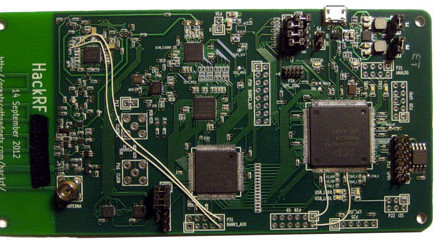HackRF Lets You Explore the Radio Waves
October 24, 2012
on
on

An astounding number of signals is traveling the radio waves. Mobile phone conversations, WiFi data, radio broadcasts, satellite television. But each of these radio protocols needs its own specific hardware device to process the signal. Software Defined Radio is going to change that. SDR consists of generic hardware platform whose functions are controlled by software, enabling the device to tune in on a wide variety of frequencies with the ease of a software update.
Michael Ossmann, a wireless security researcher and founder of the company Great Scott Gadgets, is about to release a beta version of the HackRF radio. An affordable, open source SDR that can both transmit and receive at frequencies ranging from 100 MHz to 6 GHz.
Other open source SDR initiatives already exist. There is an entire GNU radio community converting $20 digital TV USB dongles into SDRs and sharing software to process signals. At the other end of the spectrum are devices like those in the Universal Software Radio Peripheral (USRP) product line developed by Ettus Research. Its price range is beyond the reach of the average hobbyist –once you get into it you can easily spend thousands of dollars- but for the dedicated SDR fanatic its amazing equipment. The USRP can emulate a cell phone base station, air craft radar or be used to hack into police radio and crack the cryptology. USRP enables you to visualize the hidden world of radio waves as SDR wizards Balint Seeber and Matt Robert show in the video below.
Michael Ossmann aims to close the gap between of these developments. The HackRF is more versatile than the modified dongles in that it covers a broader spectrum and can not only receive but also transmit signals. And at $300 it significantly lowers the threshold of just how enthusiastic you have be to seriously dive into SDR.
Ossmann compares digitizing radio waveforms to the disruptive effects of converting audio and music into binary code. ‘Digital audio capabilities in general purpose computers enabled a revolution in the sound and music industries with advances such as hard disk recording and MP3 file sharing’, Ossmann writes on his blog.
‘Today's computers are fast enough to process radio waveforms in similar ways, and the radio communications industry is going through the same sorts of changes. One critical advance has yet to take place, and that is the availability of low cost tools enabling any computer user to take part in the revolution.’
With the HackRF board Ossmann hopes to contribute to filling the void.
HackRF is completely open source and is being developed on Github.
Source: Forbes via Slashdot
Image: HackRF board
Michael Ossmann, a wireless security researcher and founder of the company Great Scott Gadgets, is about to release a beta version of the HackRF radio. An affordable, open source SDR that can both transmit and receive at frequencies ranging from 100 MHz to 6 GHz.
Other open source SDR initiatives already exist. There is an entire GNU radio community converting $20 digital TV USB dongles into SDRs and sharing software to process signals. At the other end of the spectrum are devices like those in the Universal Software Radio Peripheral (USRP) product line developed by Ettus Research. Its price range is beyond the reach of the average hobbyist –once you get into it you can easily spend thousands of dollars- but for the dedicated SDR fanatic its amazing equipment. The USRP can emulate a cell phone base station, air craft radar or be used to hack into police radio and crack the cryptology. USRP enables you to visualize the hidden world of radio waves as SDR wizards Balint Seeber and Matt Robert show in the video below.
Michael Ossmann aims to close the gap between of these developments. The HackRF is more versatile than the modified dongles in that it covers a broader spectrum and can not only receive but also transmit signals. And at $300 it significantly lowers the threshold of just how enthusiastic you have be to seriously dive into SDR.
Ossmann compares digitizing radio waveforms to the disruptive effects of converting audio and music into binary code. ‘Digital audio capabilities in general purpose computers enabled a revolution in the sound and music industries with advances such as hard disk recording and MP3 file sharing’, Ossmann writes on his blog.
‘Today's computers are fast enough to process radio waveforms in similar ways, and the radio communications industry is going through the same sorts of changes. One critical advance has yet to take place, and that is the availability of low cost tools enabling any computer user to take part in the revolution.’
With the HackRF board Ossmann hopes to contribute to filling the void.
HackRF is completely open source and is being developed on Github.
Source: Forbes via Slashdot
Image: HackRF board
Read full article
Hide full article


Discussion (0 comments)